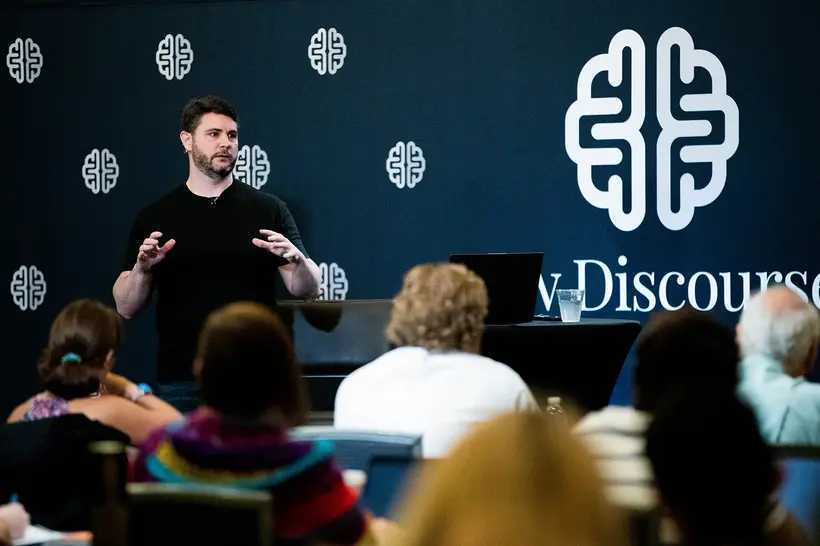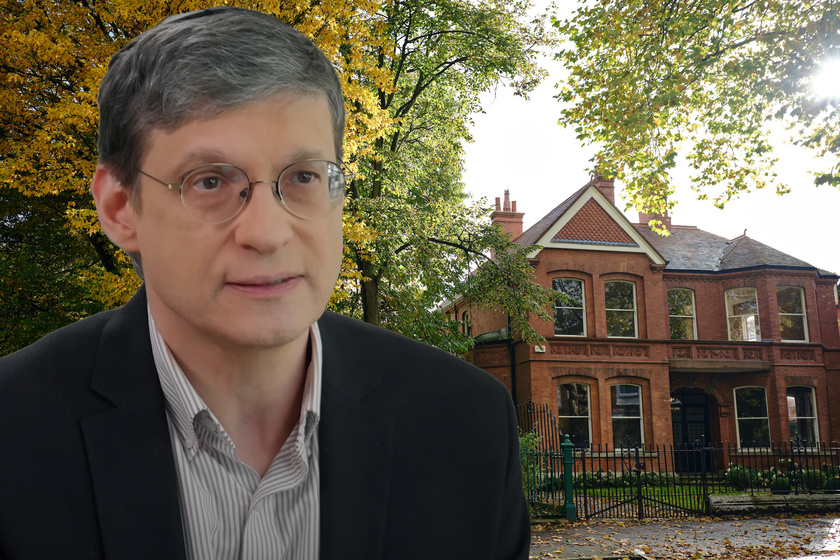What kind of conservatism trades Edmund Burke’s inheritance for Budapest’s strong-man romance, while scorning the legacy of George Washington? Yoram Hazony, one of the loudest voices in the self-styled “New Right,” presents himself as a steward of Burke’s tradition. Yet his vision is not Burkean; it is Bolshevik in temperament and Jacobin in cadence—cloaked in the language of tradition while seeking to overturn the very inheritance it pretends to guard. Hazony does not conserve. He replaces. He does not remember. He rewrites.
What he offers in Conservatism: A Rediscovery is not a recovery, but a radical revision—one that misunderstands liberalism, misrepresents history, and mistakes reaction for restoration.
Hazony’s argument, framed as a critique of “Enlightenment liberalism,” is not just conceptually confused. It is fundamentally ungrateful. In his hands, the greatest period of human flourishing in recorded history is dismissed as a failure. Liberalism, which restrained tyranny, liberated conscience, and made peaceful dissent possible, is cast not as something to preserve, but something to overcome. This is not the voice of a conservative. It is the voice of a Jacobin turned inward.
Yet this essay is not merely a rebuttal of Hazony. It is a defence of something deeper: a living inheritance—a covenant—too often caricatured or cast aside. A covenant is not a theory to be taught, but a memory to be lived—a shared moral inheritance, sustained not by compulsion but by consent. Liberalism, rightly understood, is not the ideology Hazony imagines. It is the cultural tradition Burke spent his life defending. It is not a blueprint but a bond: one that balances liberty with restraint, rights with duties, and faith with doubt. This is what Hazony cannot see, and what we cannot afford to forget.
To call Burke a liberal is not an anachronism, but a recognition of his role in shaping the tradition of ordered liberty. Though he never used the term in its modern sense, Burke stood in defence of what liberalism would come to mean: the balancing of freedom with restraint, tradition with reform, and individual rights with moral duty. As a Whig parliamentarian, he championed religious toleration, opposed arbitrary power, and upheld the rule of law as a cultural inheritance rather than a rational construct. His support for the American colonists, his outrage at British abuses in India, and his opposition to the French Revolution all flowed from a single moral intuition: that liberty must be preserved within the fabric of inherited order. In that sense, Burke was not merely a conservative of his age—he was a founder of the very conservative liberal tradition the postliberals now mischaracterise as inauthentic.
Hazony claims conservatism is empirical at heart. But Burke knew better. Conservatism is not the science of custom. It is the romance of inheritance. It does not merely tally what has worked. It loves what has endured. Burke defended the British constitution not simply because it functioned well, but because it meant something—because it spoke to the unbroken story of a people, their sacrifices, and their sacred obligations. Conservatism without romance is accountancy. And accountancy cannot stir the soul.
Yet Hazony, like a man collecting stones to build his own monument, lifts only those fragments of Burke that suit him, discarding the rest.
Liberalism is not an ideology in the modern sense. It is not a treatise to be imposed on the world, nor a set of formulas to be applied from the top down. It is a covenant—a moral inheritance passed down through habit, restraint, memory, and trust. It was not born in salons or summoned into being by declarations. It emerged from the lived experience of English-speaking peoples over centuries: from village customs and common law, from local assemblies and parish life, from the slow, often painful work of learning to live together in freedom. What we call liberalism flowered not in theory, but in practice—and only later did philosophers like Locke and Montesquieu attempt to make sense of what had already begun to take root.
This distinction matters. Hazony’s critique is built on a mistake: he confuses liberalism with abstraction, specifically rationalist universalism, when its true strength has always lain in culture and community. He attacks Enlightenment rationalism as though it were the root of Western liberalism. But this gets history backwards. The culture of freedom preceded its theoretical justifications. The American Founders, in this light, were not revolutionaries overthrowing tradition but heirs defending it—codifying in law what had long been lived in practice. The U.S. Constitution, like Magna Carta before it, was not a design from first principles but a crystallisation of moral expectations already embedded in the people.
Liberalism is not kept alive by ink and parchment, but by the daily rituals of a self-governing culture. A child does not become a citizen by reading John Locke. He becomes one by learning, slowly, that he may not take what is not his, that he must speak with civility, that he must listen before judging, and that his rights exist alongside duties. Freedom, in a liberal society, is not the indulgence of the strong. It is the restraint of the capable. And that restraint is not enforced by the state, but cultivated in the home, the playground, the parish, and the pub.
The miracle of liberal civilisation is not that it invented rights, but that it cultivated the habits necessary to uphold them. This was Burke’s central insight—that a free society cannot survive by reason alone, but must rest upon the accumulated wisdom of generations, embedded in custom, memory, and moral formation. When that memory falters, when the culture forgets the sacrifices and disciplines that freedom requires, then all the paper guarantees in the world will not save it. A right is only as strong as the people’s willingness to honour it when it is inconvenient.
Here, then, is the heart of the matter. Hazony is not merely wrong about liberalism. He is wrong about what must be conserved. He treats liberalism as an ideology to be dethroned, rather than as the covenantal inheritance of the very civilisation he claims to defend. And in his haste to unseat one abstraction, he risks empowering another—one far more brittle, and far more dangerous.
Hazony begins Conservatism: A Rediscovery with a bold claim: that “Enlightenment liberalism” became America’s dominant ideology by the 1960s—“the new framework within which American political life was conducted.” But even this opening move is on shaky ground. For one thing, it’s never quite clear what Hazony means by “Enlightenment liberalism.” He offers no serious taxonomy, nor does he attempt to distinguish between the various traditions of liberal thought. He lumps together Cartesian rationalism, Locke’s misrepresented empiricism, Rousseau’s Social Contract, and Kant’s Perpetual Peace as if all flowed from a single tap marked “reason.” In so doing, he collapses liberalism into a straw man—abstract, sterile, and wholly divorced from culture or memory.
He paraphrases Locke as holding that:
“All men are perfectly free and equal by nature; the claim that political obligation arises from the consent of the free individual, so that human individuals have no political obligations unless they agree to them; the claim that government exists due to the consent of a large number of individuals, and its only legitimate purpose is to enable these individuals to make use of the freedom that is theirs by nature; and the supposition that these premises are universally valid truths, which every individual can derive on his own, if he only chooses to do so, by reasoning about these matters.”
But this is a distortion—less a reading of Locke than a convenient effigy. Yes, Locke is an important figure in liberal thought, but to treat his abstractions as representative of liberalism as a whole is intellectually dishonest. Liberalism was not born with Locke, and Locke never claimed to define it. He, unlike Hazony, understood that philosophy is not sovereignty. Hazony, by contrast, builds a fantasy from fragments—cherry-picking what he dislikes to construct an enemy he can then righteously denounce. He does not analyse liberalism. He replaces it with a fable.
And Locke is not the only one subjected to this method. Hazony applies the same selective reading to Burke himself. He quotes Burke’s warnings against the French Revolution as if they license an illiberal reaction, but gives scant attention to Burke’s impassioned defence of American liberty, his support for religious toleration, and his reverence for the common law. Burke’s conservatism was rooted in humility, not domination—in the moral dignity of tradition, not the enforcement of orthodoxy. But Hazony lifts only those lines that seem to endorse his project, and discards the rest. This is not scholarship. It is assembly by omission.
Beneath this method lies a deeper confusion. Hazony’s entire vision rests on a brittle dichotomy: conservatism or liberalism, tradition or reason, order at the expense of individual liberty. But this is a modern fabrication, not a faithful reading of the Anglo tradition. The central error of Hazony’s entire project is his false opposition between conservatism and liberalism—a dichotomy no true Burkean would ever accept. The English inheritance Burke sought to defend was both conservative and liberal—anchored in tradition, but committed to liberty. It was not abstract universalism that animated Burke, but a deep trust in inherited freedoms, religious toleration, and common law constraints. In slicing the tradition in two, Hazony does not clarify it. He mutilates it.
This is not a one-time misreading. It is a method. Whether quoting Locke, caricaturing Burke, or invoking Protestantism, Hazony selects only those fragments that confirm his thesis, discards the rest, and weaves the remnants into a comforting fiction. His vision is not historical. It is polemical.
The reality is quite the opposite. Liberalism, properly understood, was not born of theory but of tradition. It was not summoned into being by philosophers and pamphleteers but emerged from the lived moral life of a particular civilisation—Anglo-American, Protestant, and constitutional—long before it had a name. And what Hazony calls “Enlightenment liberalism,” a concept he collapses into liberalism in the broadest sense imaginable, was not a parasite upon Protestant culture, nor even its heir. Rather, both were expressions of something greater: a civilisational covenant rooted in the dignity of the person, the integrity of conscience, and the sanctity of limits.
It is worth recalling, too, that Protestantism did not flourish in defiance of liberalism, but within it. The liberty to worship according to conscience—the very foundation of Protestant moral culture—was itself the fruit of liberal tolerance. Without the cultural safeguards of liberal institutions, the Reformation would have been remembered not as a movement, but as a massacre. English dissenters, American evangelicals, Huguenot refugees—all owed their survival not to nationalist enforcement, but to liberal restraint. It was not the imposition of a singular religious truth, but the principled refusal to impose it, that gave Protestant values the room to deepen and endure.
The liberal tradition has always contained within it a living tension—between the celebration of reason among philosophers and the faith of ordinary citizens; between abstract speculation and inherited moral restraint. It is not a brittle ideology, but a cultural form capacious enough to hold contradiction. Its beauty lies in that very tension: in its refusal to purge doubt, or to resolve complexity by force. Where others impose unity through dogma, liberalism preserves it through trust.
This is why, in 1790, George Washington, far from casting liberalism as some foreign imposition, wrote confidently that “As mankind become more liberal, they will be more apt to allow that all those who conduct themselves as worthy members of the community are equally entitled to the protections of civil government. I hope ever to see America among the foremost nations in examples of justice and liberality.” That was not Enlightenment rationalism—it was covenantal memory. It was a reflection of the culture he knew and served: one that prized order, duty, and liberty in equal measure.
Hazony’s claim that Protestant nationalism was displaced in the 1960s by liberal ideology is unconvincing on both historical and moral grounds. If anything, the liberalism that began to falter in the postwar years was already a pale imitation of the older tradition—a procedural shell emptied of cultural content. The tragedy of the twentieth century was not that liberalism triumphed over Protestantism, but that both were hollowed out by the advance of technocracy, consumerism, and ideological abstraction.
Hazony’s account grows weaker still when he alleges that liberalism’s supposed hegemony fostered a delusional universalism. Aside from Francis Fukuyama’s misunderstood End of History thesis, few serious liberals ever held such triumphalist illusions. From Burke to Tocqueville to Berlin, the liberal tradition has been marked by tragic realism, not utopian dreams. That Hazony mistakes a single speculative philosopher for a universal doctrine reveals either sloppiness or strategy. He conjures a false liberalism—ahistorical, sterile, and arrogant—only so that he may burn it down and install a state-backed orthodoxy in its place.
This tactic is not Hazony’s alone. It is a shared method among the postliberal reactionaries—those who drape themselves in tradition while scorning the traditions they never understood. Whether Catholic integralists, populist demagogues, or Orthodox ideologues, they all follow the same pattern: they identify the ashes of liberal culture and declare them proof that the fire was never worth lighting.
Hazony claims that liberalism collapsed between 2016 and 2020. He cites the rise of Donald Trump, Brexit, and nationalist victories abroad. But what he presents as liberalism’s shattering is in fact liberalism continuing to evolve. Populist governments were elected. They were criticised. Some fell. Others endured. The system held. There were no purges, no coups, no secret police. There were arguments, elections, and peaceful transfers of power. That is liberalism’s glory—not its weakness.
Hazony then turns his ire toward “woke” ideology, rightly observing its capture of institutions. But once again, he draws the wrong conclusion. That such an ideology can be named, criticised, and electorally opposed is a mark of liberalism’s resilience—not its demise. Hazony’s proposed alternative would have no such self-correcting capacity. It would trade dissent for dogma, correction for conformity.
He tacitly admires—or at least leans upon—the spectacle of the Chinese Communist Party. Early in the book he argues that the old liberal hope of “trade producing freedom” collapsed under Xi Jinping’s rule, proving liberalism naïve. That judgement is half right and wholly backward. China’s prosperity did not spring from authoritarian wisdom; it was fertilised by access to liberal markets, liberal capital, and liberal trust. Its elite studied at Harvard and LSE, not in Pyongyang. Its growth is parasitic on an order it did not build—and now seeks to undermine.
And yet Hazony invokes Beijing’s success with a tone uncomfortably close to envy, as though the CCP’s capacity for national cohesion were evidence against liberal civilisation. That is not merely wrong; it is humiliating. To quote Burke while borrowing the aesthetics of Beijing is not conservatism; it is incoherence. The China that Hazony points to is an illusion: a brittle empire of demographic collapse, youth disillusion, endemic corruption, and strategic overreach. It is a fiction tailored for foreign eyes, believed only by those who need such a mirage to justify their own revolt against liberal inheritance.
Hazony’s proposed remedy is “biblical nationalism.” Yet where Burke saw religion as a moral inheritance, Hazony would elevate it to civic orthodoxy. He calls for Sabbath observance, public displays of the Ten Commandments, and explicit governmental deference to biblical authority—public duties that push liberal neutrality aside. Reverence risks becoming rhetoric enforced by law. Faith coerced is faith diminished.
And so we return to Burke, who warned that liberty without virtue would collapse, but that virtue without liberty would become tyranny. He understood that the task of the conservative was not to tear down liberalism, but to repair it—to preserve the institutions that restrain our worst instincts, and gently reform the customs that no longer serve us. This is what we must recover: not abstract ideology, not a dogma, but a covenant—a quiet moral order made sacred by time.
The covenant of liberalism is not a universal formula. It is a living inheritance. It binds us not to theory, but to a tradition—liberty balanced with law, freedom with duty, and memory with hope. It has survived revolutions, wars, and every fanaticism of the age. It will survive Hazony, too—if we remember what it is.
But only if we remember it—not with slogans or sentiment, but with living fidelity to the covenant we inherited, and the liberty it still dares to keep alive.


















